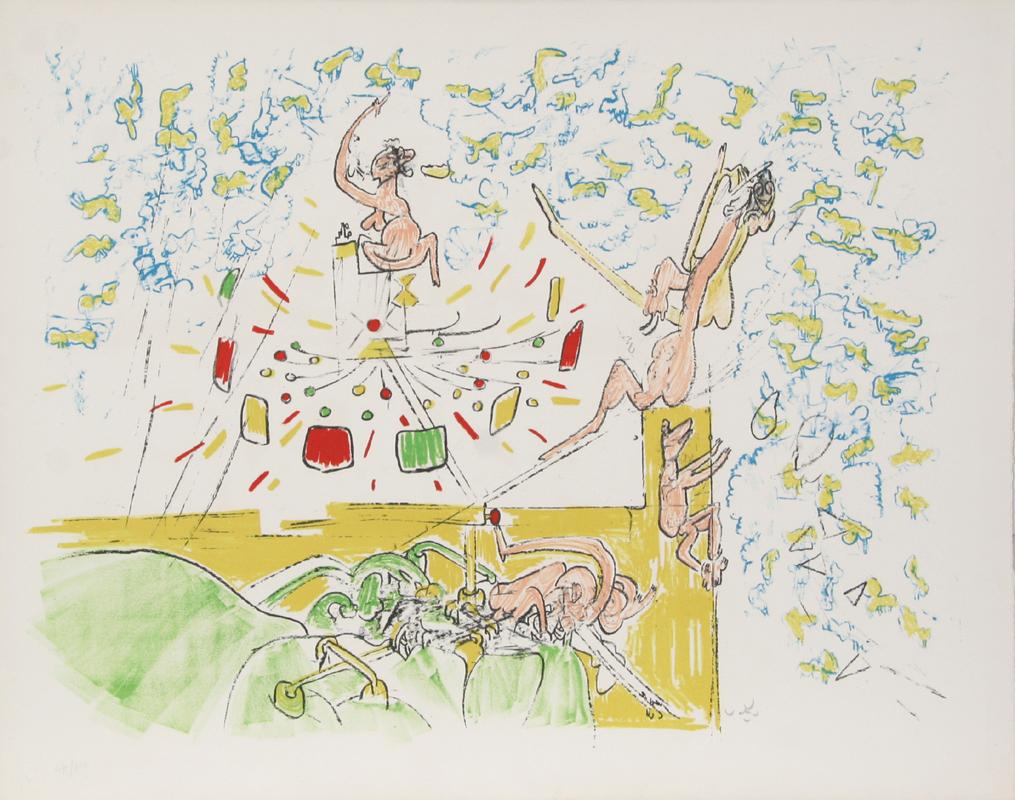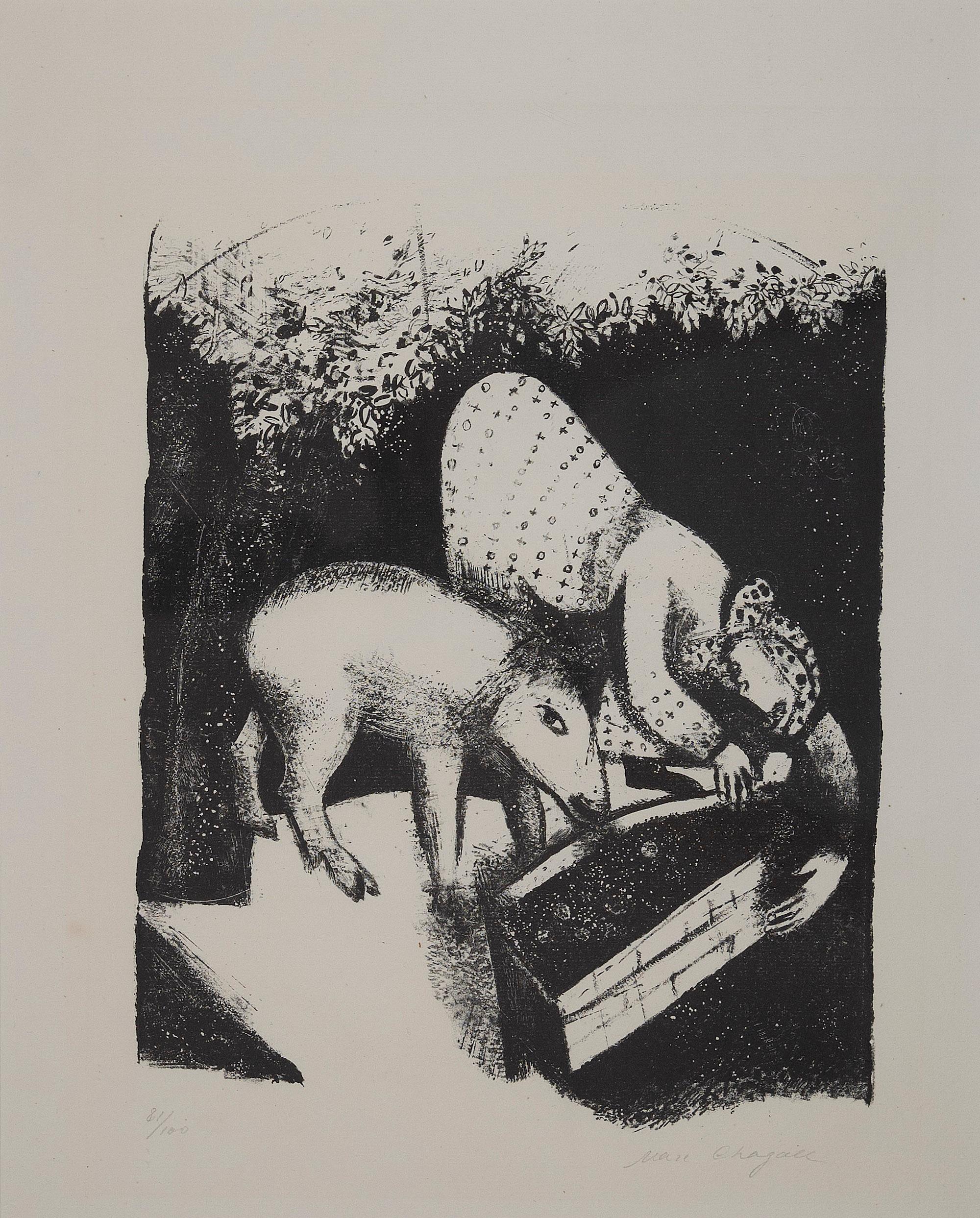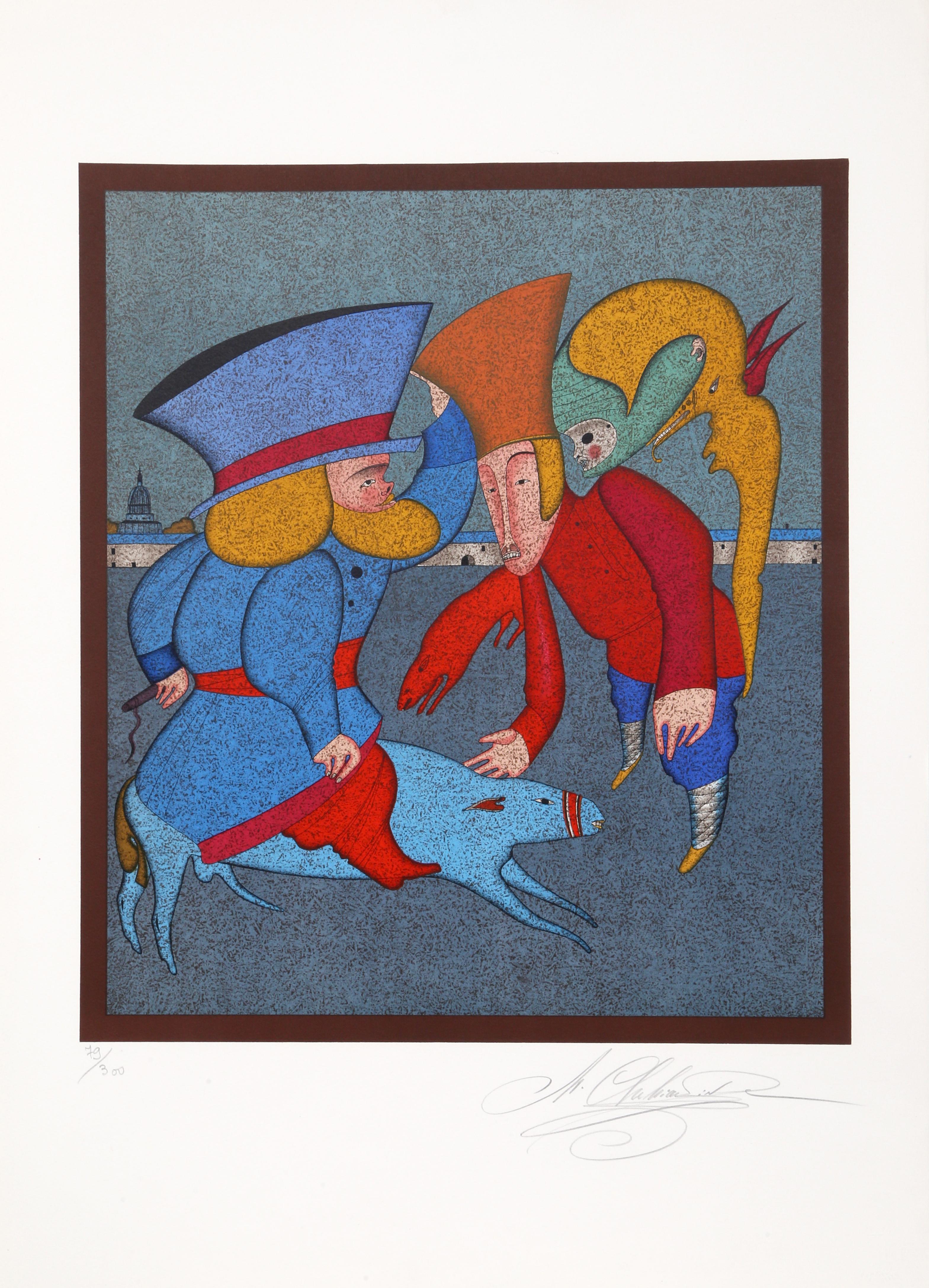Marc Chagall20th century color lithograph nude figures red and green1960
1960
About the Item
- Creator:Marc Chagall (1887 - 1985, French)
- Creation Year:1960
- Dimensions:Height: 25.5 in (64.77 cm)Width: 21.5 in (54.61 cm)
- Medium:
- Movement & Style:
- Period:
- Condition:
- Gallery Location:Milwaukee, WI
- Reference Number:
Marc Chagall
Described by art critic Robert Hughes as "the quintessential Jewish artist of the twentieth century," the Russian-French modernist Marc Chagall worked in nearly every artistic medium. Influenced by Symbolism, Fauvism, Cubism and Surrealism, he developed his own distinctive style, combining avant-garde techniques and motifs with elements drawn from Eastern European Jewish folk art.
Born Moishe Segal in 1887, in Belarus (then part of the Russian empire), Chagall is often celebrated for his figurative paintings, but he also produced stained-glass windows for the cathedrals of Reims and Metz, in France; for the United Nations, in New York; and for the Hadassah Hospital in Jerusalem, as well as book illustrations, stage sets, ceramics, tapestries and fine-art prints. Characterized by a bold color palette and whimsical imagery, his works are often narrative, depicting small-village scenes and quotidian moments of peasant life, as in his late painting The Flight into Egypt from 1980.
Before World War I, Chagall traveled between St. Petersburg, Paris and Berlin. When the conflict broke out, he returned to Soviet-occupied Belarus, where he founded the Vitebsk Arts College before leaving again for Paris in 1922. He fled to the United States during World War II but in 1947 returned to France, where he spent the rest of his life. His peripatetic career left its mark on his style, which was distinctly international, incorporating elements from each of the cultures he experienced.
Marc Chagall remains one of the past century’s most respected talents — find his art on 1stDibs.
- ShippingRetrieving quote...Ships From: Milwaukee, WI
- Return PolicyA return for this item may be initiated within 14 days of delivery.
- "La race blanche (The White Race), " Lithograph after Painting by Rene MagritteBy René MagritteLocated in Milwaukee, WI"La race blanche (The White Race)" is a color lithograph after the original 1937 painting by Rene Magritte. A female figure is made out of a mix of body parts. An eye sits on top of an ear, which is on top of a mouth, then two noses. Two breasts lying on a stomach; two arms come from the breasts. Legs are tucked under the stomach. This figure is on a sand dune next to the ocean. Art: 26.5 x 19.63 in Frame: 40.88 x 33.88 in René-François-Ghislain Magritte was born November 21, 1898, in Lessines, Belgium and died on August 15, 1967 in Brussels. He is one of the most important surrealist artists. Through his art, Magritte creates humor and mystery with juxtapositions and shocking irregularities. Some of his hallmark motifs include the bourgeois “little man,” bowler hats, apples, hidden faces, and contradictory texts. René Magritte’s father was a tailor and his mother was a miller. Tragedy struck Magritte’s life when his mother committed suicide when he was only fourteen. Magritte and his two brothers were thereafter raised by their grandmother. Magritte studied at the Brussels Academy of Fine Arts from 1916 to 1918. After graduating he worked as a wallpaper designer and in advertisement. It was during this period that he married Georgette Berger, whom he had known since they were teenagers. In 1926, René Magritte signed...Category
Early 2000s Surrealist Figurative Prints
MaterialsLithograph
- "La Reconnaissance Infinie (The Infinite Recognition)" Litho after Rene MagritteBy René MagritteLocated in Milwaukee, WI"La Reconnaissance Infinie (The Infinite Recognition)" is a color lithograph after the 1963 painting by Rene Magritte. Two of Magritte's bourgeois "littl...Category
2010s Surrealist Figurative Prints
MaterialsLithograph
- "La Page Blanche (The White Page)" lithograph after painting by Rene MagritteBy René MagritteLocated in Milwaukee, WI"La Page Blanche," or in English "The White Page," is an original color lithograph executed after the original painting from 1967 by the Belgian Surrealist...Category
2010s Surrealist Figurative Prints
MaterialsLithograph
- "Paradis (Paradise), M 232/255, " an Original Color Lithograph by Marc ChagallBy Marc ChagallLocated in Milwaukee, WI"Paradis (Paradise), M 232/255" is an original lithograph by Marc Chagall. his original color lithograph was designed for and printed by VERVE for the book “Dessins pour La Bible." I...Category
1960s Surrealist Figurative Prints
MaterialsLithograph
- 20th century lithograph black and white stylistic figurative print signedBy Joseph HirschLocated in Milwaukee, WI"Man with Scales" is an original lithograph by Joseph Hirsch. The artist signed the piece in pencil lower left. This piece depicts a man in a black robe examining the balance of the ...Category
1950s Surrealist Figurative Prints
MaterialsLithograph
- "Satan" from "Je Reve" portfolio, Surrealist Lithograph, SignedBy André MassonLocated in Milwaukee, WI"Satan" is an original color lithograph by Andre Masson. This piece is from the "Je Reve" (I Dream) portfolio of 1975. The edition number, written lower left, is H.C. XXV/XXV. The ar...Category
1970s Surrealist Figurative Prints
MaterialsPaper, Lithograph
- Les Venusiennes (II) from Fog Gog Magog Planche 3, Lithograph by Roberto MattaBy Roberto MattaLocated in Long Island City, NYArtist: Roberto Matta, Chilean (1911 - 2002) Title: Les Venusiennes (II) - Fog Ma Gog Planche 3 Year: 1971 Medium: Lithograph on Arches, signed and numbered in pencil Edition: 47/100...Category
1970s Surrealist Figurative Prints
MaterialsLithograph
- L’Auge II - Lithograph by Marc Chagall - 1925By Marc ChagallLocated in Roma, ITLithograph, 1925. Image Dimensions: 30 x 24 cm Hand signed and numbered. Edition of 100 prints. Shipped from Italy.Category
1920s Surrealist Figurative Prints
MaterialsLithograph
- Strange Rider from Carnival of St. Petersburg Suite by Mihail ChemiakinBy Mihail ChemiakinLocated in Long Island City, NYArtist: Mihail Chemiakin, Russian (1943 - ) Title: Strange Rider from Carnival of St. Petersburg Suite Year: Circa 1980 Medium: Lithograph, signed and numbered in pencil Edition: 30...Category
1980s Surrealist Figurative Prints
MaterialsLithograph
- Christopher Columbus from "Dali Discovers America" Portfolio by Salvador DaliBy Salvador DalíLocated in Long Island City, NYArtist: Salvador Dali, Spanish (1904 - 1989) Title: Christopher Columbus from "Dali Discovers America" Portfolio Year: 1979 Medium: Lithograph on Arches, signed and numbered in penci...Category
1970s Surrealist Figurative Prints
MaterialsLithograph
- La Belle Captive - Lithograph after René Magritte - 1969By René MagritteLocated in Roma, ITLa Belle Captive is an lithograph realized after René Magritte (after) in 1969. Signed on plate on the lower left corner: Magritte. Numbered in penci...Category
1960s Surrealist Figurative Prints
MaterialsLithograph, Paper
- Papageno original lithograph limited edition paintingBy Karl HodinaLocated in CORAL GABLES - MIAMI, FLPapageno original lithograph limited edition painting Original lithograph signed by hand. Perfect stateCategory
20th Century Surrealist Figurative Prints
MaterialsLithograph



